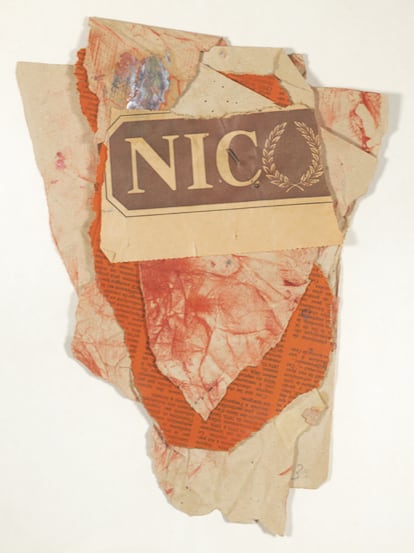'Self-portrait', from 1982, by Miguel Ángel Campano.
Once I called Miguel Ángel Campano to a fixed number finishing in seven.
We knew each other slightly.
I had been to his studio several times and we had met at various exhibitions.
He picked up the phone on the second ring and I asked for him.
"Campano is not here," he told me as if he wanted to say goodbye.
I sent him a message for when I saw him and he confirmed that I would give it to him.
Without knowing it, he had made the greatest fantasy come true when the phone rings: to unfold oneself.
It took me a second to succumb to that telephone joke, which I soon turned into a myth: that lovable and passionate artist, the one who painted in his own flesh, a free and tormented being who seemed to live in unjust hostility with himself.
More information
The painter Miguel Ángel Campano dies
The mother painting addresses the essence of the creation of Miguel Ángel Campano
Unfolding is, in fact, a word that is repeated a lot in
Painting and Evil
, the set of letters from Miguel Ángel Campano (1948-2018) to his friend and professor of philosophy Nicolás Sánchez Durá, the architect of gathering the artist's letters and who signs the beautiful prologue of the book, published by La Fábrica. An important premise: this is not a book about Campano's painting, despite the fact that the artist does not stop talking about it. The laps he gives about his condition as a "messy and maniacal" painter, he says, speak of everything that was behind his history, also pictorial: of a certain dose of loneliness in Paris in 1981, of his feeling of living at the same time. It derives from the holidays in Hyères in 1984, from the elegance of simplicity experienced in Sóller, in 1987; of the wonderful little cartoons of X in Ca'n Posteta, in 1991; of the life that smiles in Varanasi, in 1994; of his mother's health in Aubervilliers, in 2006;of the readings of his autumn 2001 in Madrid, of the list of messages in El Corte Inglés in August 2011, of his state of "cojitranca" in 2012 ...
Forty years of this unusual epistolary, in which only the voice of one of the two friends is heard, whose spirit emerges impetuous from the letters. Campano's words make up a fascinating fresco that covers the main episodes of his biography and allows us to glimpse his ideas about painting, friendship, love, family and literature. Kant and Schopenhauer are recurrent in their notes on philosophy; also black and white as colors full of hidden signs. Whoever reads these letters will see his unconditional love for Rimbaud, the names that always appeared in his memory, how Quico Rivas, who infected him with his love for Mallorca, and how his first stroke arrived, just when his little son, Manuel, was turning ten. days of life. The stroke was repeated in Paris in 2006, and his movements greatly diminished,but Campano kept looking at the pictorial bundle of brushes.
'Collage' con sanguinia y clavo, 1983, by Miguel Ángel Campano, Miguel Garcia Carceles
An action is distilled from the book that always pushed the artist to think that “we must not look back, but always forward”, despite the fact that it was so difficult for him to do so, hence his gloomy character.
The passages in which he dwells on genealogical painting are among the best of the compilation:
action painting
Cézanne, Delacroix or always Poussin, whom he looked at with hardly any distance. The other leg that gives meaning to the volume is the most intimate sphere, the doubts and drifts, which occupied each of the cities in which he lived, and which is well collected here. Whoever reads these letters will notice the phantasmagorical presence of Valencia, which returns again and again in his cultural imagination. He is moving how he talks about Capsa 13, the joint with DJs and cubalibres, where he met with other artists from Equipo Crónica, Jordi Teixidor or Carmen Calvo, and where the best voices of
underground
cinema used to run.
or the poetry of the time. "Madrid in the long run makes me a bit hysterical," he confesses on page 41. In Madrid, Vijande waited for him, to whom he also said no. Juana de Aizpuru went to see him in Paris and they signed that immaterial letter of friendship that continues to this day. With Carles Taché too, who even asked Campano to write his memoirs.
The book is full of drawings and some reproductions of the handwritten letters that fill everything with exceptionality.
Campano portrays himself in each sentence, although especially in this one: “Putting together those key paintings of my last career in Paris beginning with the
Deluge
to precisely show myself that there is only one Miguel Ángel Campano, that in reality my career is not so tortuous or a transvestite or schizophrenic ... Despite the many fancies, the mood swings, the doubts, I see a fairly straight and clear line in the last five years: let's see how all these paintings look together, I said to myself ”.
You can follow BABELIA on
and
, or sign up here to receive
our weekly newsletter
.

